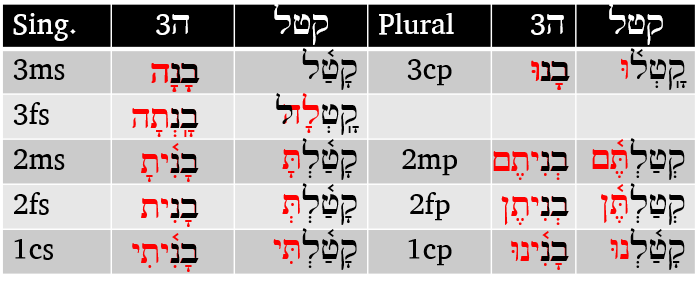14.7 Qal Perfect 3ה
3ה verbs are in a unique class and are extremely common
- \(R_3\) is not a consonant; in fact, there is no \(R_3\) consonant107
- 3ה verbs only have two root consonants, \(R_1\) and \(R_2\) - the final slot is taken up by the vowel \(\hat A\) (Qamats+Hei)
- \(V_2\) of 3ה verbs follow a unique pattern:
- If there is no sufformative, THEN add the vowel \(\hat A\) in the Perfect
- If the sufformative starts with a vowel, THEN the vowel of the sufformative is \(V_2\)
- If the sufformative starts with a consonant, THEN \(V_2\) is (vowel)+Yod
- The specific (vowel) depends on the conjugation
- For the Perfect, \(V_2 = \hat I\) (Hireq+Yod)
- Additionally, to avoid ambiguity with the P3ms, the P3fs sufformative becomes תָה
- With all these changes, the \(V_1 = \bar A\) (unless reduced in 2mp/2fp) diagnostic of the QP does not change
- 3ה Verbs are frequent, so we will want to memorize these rules and endings108
- Good news! They are consistent throughout all stems; e.g., P3ms 3ה verbs end in \(\hat A\) (Qamets+Hei) in all seven stems
Below is a summary table showing the verb בָנָה in the Qal Perfect. Note \(\hat I\) in all 2nd/1st person perfect forms.

Figure 14.2: 3-Hei Qal Perfect
- Historically, third ה verbs used to be 3-י. In some conjugations, the Yod “reappears.”
- In the Qal Perfect, the diagnostic \(V_S = \hat I\) can help you to identify the 3-ה class of verbs
Update the 3ה P3ms cell of your Stem Comparison Worksheet now!